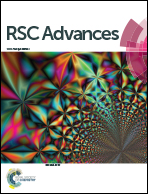Novel 3D lightweight carbon foam as an effective adsorbent for arsenic(v) removal from contaminated water
Abstract
In the present work, an efficient system for removal of pentavalent arsenic (As(V)) from water has been developed using a novel three-dimensional (3D) lightweight carbon foam. The carbon foam was synthesized from phenolic resin by a sacrificial template technique followed by stabilisation and carbonisation. The carbon foam was characterized by X-ray diffraction (XRD) for phase identification and energy dispersive spectroscopy (EDS) for compositional analysis. This same carbon foam has been utilized for the removal of As(V), and remaining concentrations were determined using an atomic absorption spectrophotometer-hydride generator (AAS-HG) at varying adsorption parameters, viz. time, pH and adsorbate dose. The adsorption data is best fitted to a Langmuir isotherm and suggests monolayer adsorption over a homogenous surface. The adsorption capacity of carbon foam is 38.4 μg g−1 and the % of arsenic removal is 99.1%, which is very high as compared to other low density carbon materials. The carbon foams efficiently adsorbed As(V) and purify water below the prescribed limits of the world health organization (WHO) and the United States-environmental protection agency (US-EPA).


 Please wait while we load your content...
Please wait while we load your content...